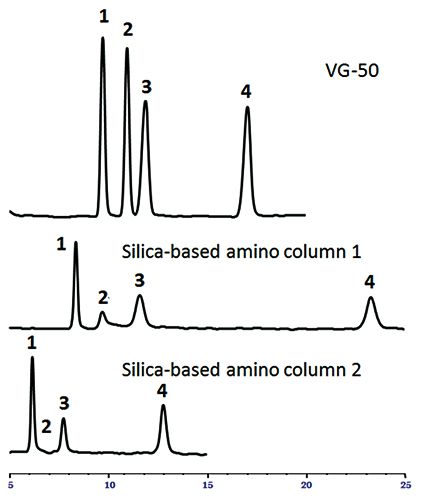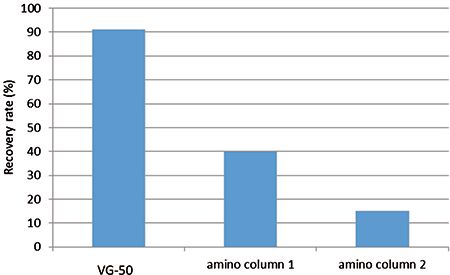A New HILIC Column for Saccharide Analysis
The Application Notebook
Due to the highly polar nature of saccharides, the analysis of sugars is typically achieved using hydrophilic interaction chromatography (HILIC).
Due to the highly polar nature of saccharides, the analysis of sugars is typically achieved using hydrophilic interaction chromatography (HILIC). Using a high polarity packing material, separation is based on the hydrophilic interactions of the sugars on the stationary phase surface typically using an eluent with a majority of polar organic solvent.
HILIC columns with amino functional groups are often used to prevent the separation of anomers; however, one drawback of the amino functional group on the packing material is the low recovery rate of reducing sugars, such as glucose and mannose. Reducing sugars are able to adhere to the packing material through the formation of a Schiff base, and must be hydrolyzed with acid for removal.
Shodex introduces the VG-50 4D column packed with a durable polymer based packing material modified with chemically stable tertiary amino functional groups. Shodex VG-50 4D is suitable for saccharide analysis, has demonstrated the separation of reducing sugars, and has been compared to two competitor silica-base amino columns.
Experimental Conditions
The analysis of four saccharides is accomplished with Shodex VG-50 4D (4.6 mm I.D. × 150 mm, 5 µm), a polymer-based amino HILIC column. The separation is compared to the same analysis using two silica-based amino columns under the same conditions. Column temperature was 40 °C and flow rate was 0.4 mL/min for the VG-50 4D analysis and 1.0 mL/min for the silica-based amino analyses. Eluent conditions are 80% acetonitrile in water. Injection volume of 5 µL of 5 mg/mL of each sugar was used for each experiment. The HPLC system was coupled with RI detector.

Figure 1: The analysis of sugars using VG-50 4D and two silica-based amino columns. Column: Shodex VG-50 4D (top) and silica-based amino columns (middle and bottom); column temperature: 40 °C; injection volume: 5 µL; eluent: CH3CN/H2O = 80/20; flow rate: 0.4 mL/min for VG-50 4D and 1.0 mL/min for silica columns. Detector: Shodex RI. Sample: 1. fructose, 2. mannose, 3. glucose, and 4. sucrose.
Results
The saccharides, fructose, mannose, glucose, and sucrose, were analyzed successfully by HPLC and RI detection with VG-50 4D and two silica-based amino columns (Figure 1). A comparison of the recovery ratio of mannose, a reducing sugar, in relation to sucrose, a nonreducing sugar, is demonstrated in Figure 2. Shodex VG-50 4D demonstrates baseline separation of the four sugars with an elution volume of 20 min and allows up to 90% recovery rate of mannose. Silica-based amino column 1 shows baseline separation of the four compounds. However, the recovery ratio of reducing sugars is 40%. Silica-based amino column 2 cannot separate the four sugars, and the recovery ratio is less than 20%.

Figure 2: Comparison of Shodex VG-50 4D and silica-based amino columns demonstrating recovery ratio of mannose. Recovery ratio = (peak area mannose)/(peak area sucrose).
Conclusions
Shodex VG-50 4D, a polymer-based hydrophilic interaction (HILIC) chromatography column suitable for saccharide analysis, has demonstrated the recovery ratio of reducing sugars compared with silica-based amino columns.

Shodex™/Showa Denko America, Inc.
420 Lexington Avenue, Suite 2335A, New York, NY, 10170
tel. (212) 370-0033 x109
Website: www.shodex.net

Robust Oligonucleotide Molecular Weight Confirmation via LC/MS
October 31st 2024Oligonucleotides—therapeutic agents for difficult-to-treat diseases—rely on precise molecular weight confirmation to ensure quality during development. Experts from Agilent Technologies explore the challenges of liquid chromatography-mass spectrometry (LC/MS) analysis in oligonucleotide synthesis, as well as strategies for accurate deconvolution, method development, and optimal equipment selection.
Development of a Fully Scalable High Efficiency 5um Solid-Core Particle to Support HPLC Workflows
October 30th 2024In this work the development of two key attributes of the 5um CORTECS Columns is examined. First column efficiency is compared across CORTECS and other solid-core 5 μm columns. Next scalability from sub-2 μm to 5 μm particles is examined between the CORTECS Column lines and competitive column lines. It was found that CORTECS columns have higher efficiency compared to other solid-core columns and that CORTECS particles are fully scalable.
HILIC Peptide Retention Times Predicted Using New Approach
October 29th 2024Manitoba Centre for Proteomics and Systems Biology scientists produced a new means of predicting peptide retention times for hydrophilic interaction liquid chromatography (HILIC) at acidic pH in formic-acid based eluents.